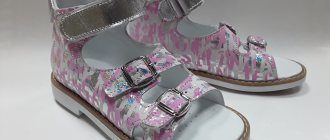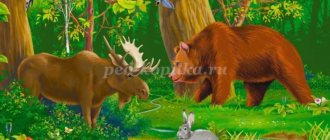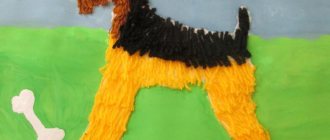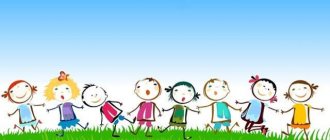Finger gymnastics.
Squirrel
A little squirrel is jumping on the branches. A tail flashes among the branches. Who will keep up with her?
Use your thumb to touch the remaining fingers in turn, performing the exercise first with one hand, then with the other.
Bunny
The gray bunny jumps deftly, He has a carrot in his paws. Lean your elbow on the table, spread your index and middle fingers to the sides, clench the rest into a fist and clench and unclench these two fingers for each word. Wild animals
This is a bunny, this is a squirrel, this is a fox, this is a wolf,
Bend your fingers into a fist, starting with the little finger.
And this is a brown, furry, funny bear cub, in a hurry, hobbling sleepily.
Rotate with your thumb. A hedgehog is walking
A hedgehog walks without paths through the forest, through the forest. And with its thorns it pricks and pricks.
Tap your palm with your nails. And I’ll show the hedgehog that path,
Draw a snail on your palm with the pad of your index finger.
Where mice roll little cones.
Rub your knuckles into your palm.
Squirrel, Hungry Mouse, Dinosaurs, Hedgehog
Squirrel A playful squirrel is jumping, (“running” with its fingers on the table) tearing pine cones from the pine branches. (they clench their fists on their right and left hands alternately) He deftly squeezes it with his paws (they clench their fists on their right and left hands at the same time) and carries it to his closet. (“run” their fingers across the table)
Squirrel A squirrel sits on a cart, (they clap their palms and hit each other with their fists alternately) She sells nuts: To the little fox-sister, to the sparrow, to the titmouse, to the thick-fifted bear, to the mustachioed bunny - (bend one finger at a time, starting with the thumb) To whom in a scarf, To whom in the goiter, in the sweetheart. (clap palms rhythmically and strike with fists)
Squirrels One, two, three, four, five, (put out five fingers) The squirrels came to play. (hide your hand behind your back) One has disappeared somewhere, (put out four fingers) There are four squirrels left. (hide your hand behind your back) Now quickly look - there are already three of them left. (put out three fingers) Well, well, what a pity, (hide your hand behind your back) We only have two left. (put out two fingers) This news is so sad - (hide hand behind back) There is only one squirrel left. (put out one finger) While you and I were counting, the Squirrels ran away from us. (hide your hand behind your back)
Dinosaurs Dinosaurs at dawn (hands clenched into a “lock”) Children saw in the park, They got scared, trembled, (we pretend to tremble, fright) They quickly ran to the house, (“running” with their fingers on the table) The dinosaur, believe it or not, Just tra- voracious beast. (hands clenched into a “lock”)
Hedgehog We found a prickly ball, We can’t hold it. The ball is spinning in his palms, the ball wants to run away. (children roll massage balls between their palms) Our ball is alive and warm, Who does it look like? (they look at the ball, holding it in their palms) The ball jumped onto the path - It turned out... it's a hedgehog! (children lower their hands, the balls fall and roll on the floor)
The hedgehog was stomping along the path The hedgehog was stomping along the path And he was carrying mushrooms in a basket. (we make walking movements with our fingers spread out) To count the mushrooms, you need to bend your fingers. (children bend their fingers in turn, first on their left hand, then on their right hand; at the end of the exercise, their hands should be clenched into fists)
Articulation gymnastics.
The material for articulatory gymnastics is taken from the book by O. A. Novikovskaya “Fun exercises for the tongue. Games for speech development"
"In the forest"
We visited the forest and met a fox there. The fox has a sharp, long muzzle. Here it is...
Extend your lips with a tube and hold them in this position for several seconds.
We saw wolves running behind the tree. The wolf growled - Showed his teeth.
Pronounce the sound [Y] for a long time; To do this, open your mouth, bare your teeth, push your lips forward like a mouthpiece; When performing the exercise, clench your hands into fists and, bending them at the elbows, raise them upward.
And then with fangs - click! So that they know who the wolf is here.
Wrinkle your nose, make a grin, exposing two rows of teeth, and then click your teeth.
A bear was dozing under a pine tree. When he woke up, he began to cry.
Pronounce the sound [Y] for a long time, while opening your mouth and moving your lips slightly forward.
The little bunny heard him. Trembling in the bushes, little coward. He sits and barely breathes, he doesn’t even move his ears. Like this…
Take a deep breath in through your nose and exhale slowly through your mouth, place your palms on your stomach and watch its movements - increasing in volume as you inhale and decreasing as you exhale.
The little bunny began to gnaw on the stalk root.
Raise the upper lip, exposing the upper teeth - incisors. Click your teeth.
Without paths, without paths A hedgehog walks through the forest. The mushroom is huge and snorts contentedly. Like this…
Briefly pronounce the sound [F] several times in a row; to do this, raise your upper lip and touch your lower lip to your upper teeth.
And along the branches, hop-hop, Belka is a red-haired animal. Let's treat her to a nut. Look, the squirrel puts a nut on his cheek, and now on the other. Like this…
Place the tip of your tongue either on the right or on the left cheek, protruding it from the inside.
Leave your comment
Yamal authorities have made preferential education more accessible for children from indigenous northern families
Reading time: 2 minutes
An Italian teacher gave children a summer assignment and became famous
Reading time: 4 minutes
Chinese University Enrolls Artificial Intelligence in Computer Science Faculty
Reading time: 1 minute
Early start of classes negatively affects student performance
Reading time: 2 minutes
Reading time: 1 minute
Rosobrnadzor: almost half of teachers do not reach the basic level of training
Reading time: 2 minutes
Gift certificates
Responsibility for resolving any controversial issues regarding the materials themselves and their contents is taken by the users who posted the material on the site. However, the site administration is ready to provide all possible support in resolving any issues related to the work and content of the site. If you notice that materials are being used illegally on this site, please notify the site administration using the feedback form.
Breathing exercises
The frog opens its mouth. And he exhales noisily... There!
Raise your arms up and make a circular motion. On the word “Here”, continue exhaling with the sound “...fff”. Come on, stick out your belly - it turns out to be a hippopotamus. Now, pull your stomach in. Our hippo has lost weight.
Place your hands on the diaphragm area. Exhale the remaining air, inhale smoothly and leisurely through your nose and mouth so that the upper front wall of the abdomen sticks forward, raising your arms. Exhale through the mouth smoothly and as completely as possible. At the same time, the stomach lowers and retracts at the end of exhalation. To control oral exhalation, it is recommended to pronounce the sounds “shhhh...” or “fff...”.
Hide and seek, Gray wolf, Gray bunny, Bunny galloping, Elephant
Hide and seek The first bunny is under a leaf, (bend the thumb) And the second one climbed into the barrel. (bend the index finger) The third bunny with a scythe sits quietly behind a pine tree. (they bend the middle one) The fourth one sits on the stump. (they bend the nameless one) The fifth climbed onto the log, (they bend the little finger) He jumped off the log and disappeared. (unbend the little finger and “hide” it in the fist of the other hand)
Gray wolf The wolf is gray, toothy, (bends and unbends his fists) prowls around the field, (“walks” his fingers on the table) looking for prey. When he finds it, (clench his fists) he gives it to the wolf cubs.
The deer has a big house, Morning, Fur coat
The deer has a big house - The deer has a big house (put your hands with spread fingers to your head, depicting horns, then make a house with your hands above your head, connecting your fingers and spreading your elbows in different directions; we spread our arms to the sides: we show how big the house is) — He looks out his window. (bend both arms at right angles at the elbow, hold forearms and palms parallel to the floor, hold one hand at chest level, the other slightly above the head, look out the resulting “window”) - A bunny is running through the forest (show with your hands what kind of ears the bunny has, with the help of your palms; show on the table how the legs are running, or imitate running) - There is a knock on his door: - “Knock, knock, open the door, (“knock on the door” with a fist in the air, make a movement similar to opening the door) - There’s an evil hunter in the forest” (point to the side, then draw a weapon: stretching one hand out in front, straighten the index finger, clench the remaining fingers into a fist; attach the second hand, bent at the elbow, press the index finger of the bent hand extended forward with the side below the elbow straight hand) - “Run quickly, - Give me your paw” (we show the movement with our palm when someone is called, and extend our palm, as if for a handshake)
Morning In the morning, bunnies woke up on the lawn. (the hand with the “hares” is placed on the table with the back side down) - Hello, red sun! (thumbs up) - Hello, clear skies! (the index finger rises, the thumb remains raised) - Hello, Christmas tree! (middle finger rises, thumb and index finger remain raised) - Hello, stump! (the ring finger rises, the thumb, index and middle remain raised) - Hello, hello, New Day! (little finger rises - all the bunnies have woken up)
Fur coat: Gray fur coat of a wolf, Fur coat of a hedgehog with needles, Fur coat of a red fox - Of amazing beauty. The hare's coat is white, the bear's is brown. (they bend their fingers one by one, listing wild animals and the colors of their “fur coats”) He is not afraid of rain and gloomy weather. (shakes head from side to side)
Source
Development of lexical and grammatical categories in preschool children on the topic “Wild Animals”
Goal: to organize effective conditions that ensure the formation of a full-fledged structure of speech activity in students with speech disorders.
Tasks:
- development of fine motor skills,
- expand and activate vocabulary on the topic,
- consolidate the general concept of “wild animals”,
- strengthen the skill of forming plural nouns,
- learn to form possessive adjectives,
- consolidate the skill of using plural nouns in the genitive case,
- learn to coordinate the endings of singular and plural nouns in the instrumental case,
- learn to coordinate the endings of singular nouns and adjectives,
- learn to form names for baby wild animals,
- develop phonemic awareness skills,
- learn to select verbs for nouns,
- learn to choose words - antonyms,
- development of coherent speech (drawing up a descriptive story according to a plan, retelling a text according to a question plan).
Equipment: images of wild animals and their young, an image of a forest, a diagram for describing animals.
Literature:
- Agranovich Z.E. A collection of homework assignments to help speech therapists and parents overcome lexical and grammatical speech underdevelopment in preschoolers with OSD. 2012.
- Practical speech therapy: summary of classes on speech development in preschool children / E.N. Krause. – St. Petersburg: Corona-Vek, 2008. – 80 p.
- T.A. Tkachenko Schemes for preschoolers to compile descriptive and comparative stories for manuals Learning to speak correctly.
- Formation of coherent speech of children 4 – 5 years old: planning, lesson notes, lexical material / author.-comp. L.N. Sweets. – Volgograd: Teacher, 2011. – 232 p.
CONTENT:
1. Announcement of the topic.
Speech therapist: guess the riddles and guess who we will talk about today. (Children: Let's talk about wild animals.)
1) Fluffy tail, golden fur, lives in the forest, steals chickens in the village. (Fox)
2) In summer he walks without a road, near pines and birches, and in winter he sleeps in a den, hiding his nose from the frost. (Bear)
2. Finger gymnastics.
Wild animals are found in the forest. Here you can see a wolf and a fox, a hare and a bear, a squirrel, a wild boar. Forest silence hides everyone securely.
(Consistently connect the fingers of the right hand with the thumb.) (Consistently connect the fingers of the left hand with the thumb.) (Consistently connect the fingers of the right and left hands.)
(Clench and unclench your fingers into a fist on both hands.) (At face level, spread the fingers of both hands - “hide”)
3. Game "Who has who?"
Speech therapist: Name the baby wild animals. The fox has a little fox, the wolf has ..(wolf cub), the bear has ... (teddy bear), the elk has ... (calf), the squirrel has ... (calf), the hedgehog has ... (hedgehog), the deer has ... (fawn), etc.
4. Game “Who are there many in the forest?”
Speech therapist: look at the image of a forest clearing and tell me who is there in the forest?
(Children: there are a lot of foxes, bears, wolves, hedgehogs, raccoons, moose, deer, etc. in the forest.)
5. Game "Guess who it is?"
Speech therapist: I will list you the words-signs, and you will select the appropriate animal for them. Speech therapist: big, brown, shaggy, club-footed, clumsy. (Children: bear.) Speech therapist: gray, angry, toothy, angry, hungry. (Children: wolf.) Speech therapist: cunning, fluffy, red-haired, agile. (Children: fox.) Speech therapist: small, long-eared, timid. (Children: hare.)
6. Game "Fourth wheel".
Speech therapist: listen and name the extra word.
Hedgehog, hedgehog, knife, hedgehog. Fox, fox, fox, fox. Mole, raccoon, raccoon, raccoon. Deer, deer, deer, laziness. Squirrel, hare, cat, bear. Deer, elk, hawk, wild boar. Goat, pig, bear, horse.
7. Finger gymnastics “Hedgehog”.
A hedgehog lives under a pine tree. He has a lot of needles. How good he is - He looks like a brush. If he wants food, the hedgehog will go looking for food. Place your hands with your elbows on the table and spread your fingers. Place your palms together and interlace your fingers (needles). Move your fingers - “needles”. Move your fingers - “needles”. Move your fingers - “needles”. Turn the hedgehog’s “face” to the right – to the left. (in different directions.)
8. Game “Who eats what?”
Speech therapist: name the animal and tell us what it eats. Children: The bear eats berries, honey, fish and small animals. The hare eats bark, twigs, and grass. The squirrel eats nuts and mushrooms. The wolf eats animal meat. The hedgehog eats mushrooms, mice, beetles, and apples. The fox eats mice.
9. Game “Who moves how?”
Speech therapist: I name the animal, and you answer what this animal does, how it moves.
The bear (what is it doing?) – walks, climbs, swims, runs. Hare - jumping, galloping, running. Wolf, fox - run, walk. Squirrel - jumps, runs, climbs. Hedgehog - walks, runs, rolls.
10. Game "Confusion".
Speech therapist: correct my mistakes. Speech therapist: white fox. (Children: red fox.) Speech therapist: blue bear. (Children: brown bear.) Speech therapist: purple squirrel. (Children: red squirrel.) Speech therapist: black hare. (Children: gray hare.)
11. Game "Say the opposite".
Speech therapist: add the correct word.
The hare is cowardly, and the wolf, on the contrary, ... (brave) The bear is simple-minded, and the fox, on the contrary, ... (cunning) The bear is clumsy, and the squirrel, on the contrary, ... (dexterous, agile) The raccoon is small, and the bear, on the contrary, ... (big. ) The bear has large tracks, and the squirrels, on the contrary, are... (small) The fox is fluffy, and the hedgehog, on the contrary, is... (prickly)
12. Game "Whose Tail?"
Speech therapist: answer the question: whose tail?
A hare has a tail - ... (hare), a bear has a tail - ... (bear), a fox has a tail - ... (fox), a squirrel has a tail - ... (squirrel).
13. Puzzles.
He lives in a hollow tree and gnaws nuts. (Squirrel.)
Red-haired, with a bushy tail, lives in a hole under a bush. (Fox.)
White in winter and gray in summer. (Hare.)
cracks nuts accurately, well, of course, this is... (a squirrel.) Walks in the summer, rests in a den in the winter. (Bear.)
In a dense forest, under a fir tree showered with leaves, lies a ball of needles, prickly and alive. (Hedgehog.)
14. Writing a story - description.
Speech therapist: tell us about a wild animal according to the following diagram:
- appearance of the animal (body part),
- where he lives,
- what does he eat,
- what is the name of his cub,
- in what fairy tales or cartoons does this animal appear?
15. Retelling of the text “The Hedgehog Family”.
Speech therapist: listen carefully to the story about the hedgehog family, then you will answer my questions and try to retell this story.
A family of hedgehogs A family of hedgehogs lived in a hole at the roots of an old spruce tree. Often the hedgehog's mother went hunting, and the little hedgehogs sat quietly without her. One day Anya and Yegorka saw them in a hole. “Anya, don’t touch them,” said Yegor, “the hedgehogs are still very small.” “I’ll just pet the hedgehogs,” Anya answered. The next morning the children came again to the hedgehogs' hole and saw that it was empty. At night, the hedgehog took her hedgehogs to another, safe place. Speech therapist: where did the hedgehog family live? (Children: a family of hedgehogs lived in a hole at the roots of an old spruce.) Speech therapist: why were the hedgehogs often left alone? (Children: the hedgehogs were often left alone because the hedgehog’s mother went hunting.) Speech therapist: who found the hedgehogs? (Children: Anya and Egorka found the hedgehogs.) Speech therapist: what happened the next day? (Children: the next day there was no hedgehog in the hole; the hedgehog took them to another safe place.)
16. RESULT OF THE LESSON:
Speech therapist: who did we talk about today? (Children: we talked about wild animals.) Where do wild animals live? (Children: wild animals live in the forest.) What did we learn today?
Gordienko Marina Anatolyevna speech therapist, Sevastopol







